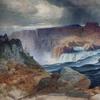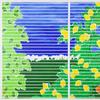Make Room for Color Field Opens at Nelson-Atkins
- KANSAS CITY, Missouri
- /
- December 14, 2015

A single act of generosity by a collector and supporter of The Nelson-Atkins Museum of Art in Kansas City has resulted in the gifting of five more works of art, a handful of loans, and an installation celebrating Color Field painting. Luther W. Brady, M.D., one of the world’s foremost oncologists, gifted the museum with Jules Olitski’s Embraced: Yellow and Black, in the memory of his dear friend Joanne Lyon, a longtime supporter of the Nelson-Atkins. Inspired by that gift, an anonymous donor loaned the Nelson-Atkins Helen Frankenthaler’s Elberta, another quintessential example of Color Field painting. Then Kristina Olitski gave the Nelson-Atkins four Jules Olitski prints to complement one already owned by the museum, thereby creating a complete set. The recent acquisitions, not including the Olitski prints, will be celebrated in the installation Make Room for Color Field, which opens Dec. 11.
“This is not just a celebration of the color field movement, which was pioneered in the search for a style of abstraction that expressed a yearning for transcendence,” said Julián Zugazagoitia, Menefee D. and Mary Louise Blackwell CEO & Director of the Nelson-Atkins. “It is also a celebration of the generosity of our donors, whose vision makes it possible for these magnificent works to be appreciated by a larger audience.”
A loan from collectors and patrons Jim Sight and Dr. Heidi Harman is included in the installation, Wet Heat Company by Jules Olitski, as well as Louis Morris’ Beth Peh, loaned by a private collection.
Helen Frankenthaler, Morris Louis, and Jules Olitski were seminal to the Color Field movement, which emerged in the late 1950s and early 1960s. Color Field painting is lyrical, poetic and relies upon the primacy of large swaths of radiant color and the interactions of color and form, to convey its meanings. It also refers to the technique of thinning paint to the consistency of water color and applying it to unprimed canvas, often by pouring, such that it soaks and stains the material—color literally becomes part of the picture’s surface. The painting process is itself crucial, and is a delicate balance of skill and chance.
“Color Field is characterized by large scale,” said Leesa Fanning, Curator, Contemporary Art. “The works absorb the viewer by flooding their peripheral vision, enveloping them in the atmosphere of color. The saturated, bright colors stress the contrasts of pure hue rather than contrasts of light and dark.”
Jules Olitski was an American abstract painter, printmaker and sculptor and an important figure in the Color Field movement of the late 1950s and early 1960s, staining canvases with large areas of thin, brightly colored pigments. Kristina, his wife of 32 years, gifted the Nelson-Atkins with four of her deceased husband’s prints.
Philadelphia oncologist Luther Brady has long been involved in the arts, and has worked on behalf of the Philadelphia Museum of Art both as Chairman of its Executive committee and as a member of its Board of Trustees.











_(17100x100_c.jpg)




